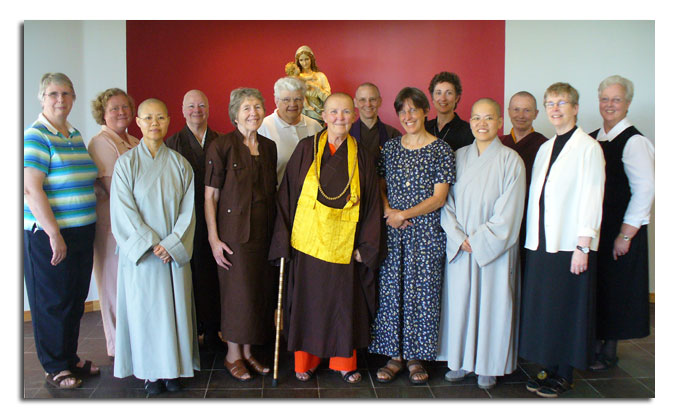Nuns in the West III / Teachers and Training for the Inner Life
by Sr. Katherine Ann Smolik, OSB

The principal coordinator for Nuns in the West III reports on the session that was held at St. Mary Monastery over the Labor Day weekend.
Nuns in the West III, the third in a series of dialogue events sponsored by Monastic Interreligious Dialogue, was held Friday, August 29, through Monday, September 1, 2008, at St. Mary Monastery in Rock Island, Illinois. The first two gatherings, held in 2003 and 2005, were hosted by Ven. Yifa at the Hsi Lai Temple in Hacienda Heights, a suburb of Los Angeles, California. Some of the Buddhist nuns from Nuns in the West II had expressed an interest in meeting at a Christian monastery and Sister Catherine Cleary’s community graciously offered us their space for Nuns in the West III. Rev. Vivian Gruenenfelder from Shasta Abbey in Mt. Shasta CA, and I were the co-facilitators.
Our Buddhist sisters came from a variety of traditions around the United States:
Ven. Dr. Karuna Dharma,Vietnamese Zen Buddhism
Rev. Vivian Gruenenfelder, Soto Zen Buddhism
Ven. Karma Lekshe Tsomo, Tibetan Buddhism
Rev. Zuiko Redding, Soto Zen Buddhism
Bhikshuni Kungshih Shih, Chinese Ch’an Buddhism
Bhikshuni Konghuan Shih, Chinese Ch’an Buddhism
The Christian nuns all came from the Benedictine tradition:
Sister Joan Therese Anderson
Sister Barbara Austin
Sister Catherine Cleary
Sister Bridget Dickason
Sister Meg Funk,
Sister Anne McCarthy
Sister Hélène Mercier,
Sister Katherine Ann Smolik
To begin we joined the monastic community of St. Mary Monastery for Evening Prayer (Vespers) and supper. This was followed by formal introductions in the conference room of Benet House, St. Mary’s retreat center. Sister Meg explained how the first Nuns in the West began—the “genetic moment” in her words. She and Ven. Yifa conceived the Nuns in the West project at the 2002 Gethsemani Encounter. They and the other women participants at Gethsemani II envisioned an event at which” just nuns” would gather and dialogue in a more intense way and at a deeper level of personal relationships. There were to be no media, observers, or formal papers. This proposal was subsequently approved at an annual Monastic Interreligious Dialogue board meeting and the idea was on its way. The first gathering was so positive that another meeting was held two years later in 2005. According to Sister Meg, it has become “one of the most important events of interreligious dialogue that Monastic Interreligious Dialogue has ever sponsored.”
Our first evening continued with each nun introducing herself, identifying the tradition and/or lineage she comes from, the monastery or temple she resides at, and her country of origin. We were blessed with a diverse group of Buddhists. This sharing helped us to get to know each other so that we could move into our more formal dialogue on Saturday.
“Meditation and Prayer” was selected as the topic for this year’s meeting. This theme was also an important part of the previous Nuns in the West discussions. Prior to our gathering some questions for dialogue were proposed to help lead us into our discussions. These questions were grouped into three main categories:
1. The inner life of training.
2. Who are our teachers? From whom do we learn?
3. Integrating our meditation/prayer.
As we talked, the group moved to the topics that seemed most pressing to us at this time. As a consequence, we focused on the first two categories:
Inner Life of Training
1. What do meditation, prayer, contemplation mean in your tradition?
2. Can you describe your practice?
3. What do you do with your mind?
4. What is the purpose of your meditation/prayer?
5. What are the short term/ long-term goals?
6. To whom do you pray?
7. What is right effort?
8. How do you practice mindfulness?
9. Unity vs. Duality –what is the starting point in your tradition?
10. Is Buddha as essential for Buddhists as Christ is for Christians?
11. Are there cautions for Christians wanting to take up an Eastern prayer or meditation practice?
12. What teachings support your practice?
13. What can we learn from each other?
From whom do we learn?
1. Who are our teachers?
2. What is the role of the teacher?
3. Do we have enough teachers?
4. How do we recognize our teachers?
Ven. Lekshe and Sister Joan Therese started us off on Saturday by defining how the words meditation, prayer and contemplation are used in each tradition, since the terms are interpreted differently. Ven. Lekshe’s talk brought to light the tremendous training of the mind that has been fundamental to the Buddhist tradition for the past 2500 years. Buddhist practice is about self-effort, so Buddhists have strict and effective disciplines to train the mind. They also have Vinaya precepts to integrate daily life. Sister Joan Therese spoke about Christian meditation emphasizing the element of “grace” that we rely on. Contemplation—being present to God in silence—is for Christians a total gift, but still requires dedication. Teachings and practices to train the mind are present in both traditions and demand strenuous effort on the part of the practitioner. In the Christian tradition, however, these teachings and practices need to be reclaimed.
Each of the nuns was asked to describe her meditation or prayer practice. We spoke in trust and listened with respect to a rich sharing that was both enlightening and a special privilege. Our sharing led to more serious discussions on the mixing of traditions. For example, can a Christian nun or priest also be an ordained Zen Roshi?
Our conversation helped to clarify a fundamental difference between the Buddhist and Christian experiences. Christians enter into a relationship with God, going to God, the Creator, through Jesus Christ, the Only Begotten of God. The relationship with Jesus Christ is what makes our relationship with God personal, and not just that of creature to Creator. The Buddhist worldview is very different: there is no creator God, and their reference point is “emptiness.” A few of the Buddhist nuns said, for example, “There is no object of meditation and no goal.” The Buddhist experience is “unmediated,” and there is no relationship with a loving God from whom all things come.
As we continued our dialogue we delved into some of the problems that have arisen in the last twenty years because of the assimilation of practices that do not belong to our original tradition. More specifically, we asked, “What are the pitfalls of Christian meditation?” We agreed that this was a very serious question and deserved our attention, especially since it kept surfacing. Sr. Meg Funk deals with some of these issues on her website . One of the Buddhists grouped our concerns from this dialogue into three categories: psychological problems, authentication of teachers, and unseen forces.
From the discussion of pitfalls, we then framed the question in a more positive way: “What resources—training and teachers—do we have to avoid these problems? Who are the qualified teachers in each tradition?” This led to one of the most fruitful discussions of the weekend. Christians need to find a teacher with purity of heart and skillful means. As Sister Meg observed, “The West has no training of teachers that is based on some validity of personal sanctification, but only training based on completion of courses and required studies and some witness that there are no grave impediments. We need more training of the mind as in our earlier desert tradition and in later Orthodox traditions. We need to take another look at precepts.” The Buddhist system of authentication of teachers, based on lineages and transmission from master to disciple, is more mapped out. Also, monastic “vows” in the Buddhist tradition are being reclaimed by nuns from ancient traditional lineages that have been broken through historical circumstances. Rev. Vivian also noted that she appreciated seeing training that was being lived out.
While our formal dialogue sessions ended on this note, our chanting, rituals, and informal sharing continued. Sister Hélène led us in an exercise of Christian Lectio Divina, we prayed a Buddhist “vesper service” complete with a procession and bowing, and we learned about Sakyadhita programs to benefit woman and nuns in India, Tibet and other Asian countries. Finally, we listened to Buddhist chanting in Tibetan, Vietnamese, Chinese, and Japanese as part of a closing ritual. We expressed our gratitude and concluded with the “Dedication of Merit” (Buddhist), chanted in Vietnamese, and the Salve Regina (Christian), sung in Latin.
However, our discussions continued on late into the evenings and bonded our relationships as sisters on the monastic path. This was truly a blessed encounter.

Nuns in the West III / Photo Album
* Sr. Katherine Ann Smolik is a member of the Benedictine Sisters of Perpetual Adoration and currently resides at her community's motherhouse in Clyde, Missouri. She participated in "Nuns in the West II" in Los Angeles, Gethsemani III, and coordinated the recent "Nuns in the West III" dialogue held at St. Mary Monastery in Rock Island, Illinois. She is a member of the Board of Directors of MID.
|